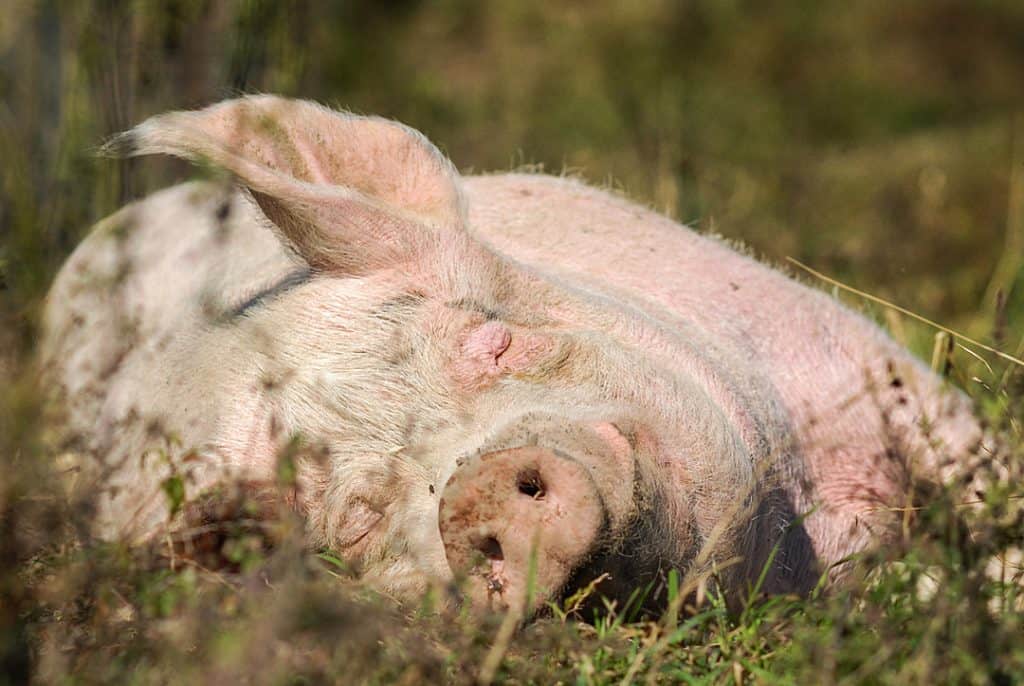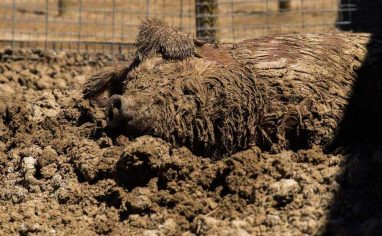
This resource was updated on April 12, 2024, as part of the veterinary review process. It was originally published on February 28, 2018.

Veterinary Review Initiative
This resource has been reviewed for accuracy and clarity by a qualified Doctor of Veterinary Medicine with farmed animal sanctuaryAn animal sanctuary that primarily cares for rescued animals that were farmed by humans. experience as of April 2024. A previous version was reviewed in June 2021.
Check out more information on our Veterinary Review Initiative here!
A Note For Folks Who Have Our Care Program Evaluation Checklist!
Because the field of veterinary medicine is always evolving, sometimes our guidance needs to be updated as veterinarians and other veterinary professionals learn more about certain health conditions or the long-term outcomes of certain interventions. Such is the case with our guidance regarding the spaying of female pigs. If you have our Care Program Evaluation Checklist, please be aware that this book contains our previous guidance. We plan to review and update the Care Program Evaluation Checklist in the future and will be sure to make the appropriate changes regarding our guidance regarding spaying pigs. In the meantime, please refer to this resource for our most current recommendations.
If you’ve cared for dogs or cats, you might already know the importance of spaying and neutering. The reasons for spaying and neutering pigs are largely the same, but some unique characteristics of pigs elevate the procedure to one critical for their health and safety.
Why Is Spaying And Neutering Important?
Male pigs should be neutered (castrated) by a veterinarian to prevent unexpected fatherhood (some breeds can become sexually active as soon as two months old!). Neutering also:
- Reduces confrontationalBehaviors such as chasing, cornering, biting, kicking, problematic mounting, or otherwise engaging in consistent behavior that may cause mental or physical discomfort or injury to another individual, or using these behaviors to block an individual's access to resources such as food, water, shade, shelter, or other residents. behaviors towards other pigs, people, and their surroundings
- Prevents overly strong body odor
- Reduces their impulse to wander away from home
- Reduces their impulse to mark their territory
- Reduces the likelihood of testicular tumors and prostate infections, which are endemic in unaltered males.
Female pigs should be spayed by a veterinarian to eliminate pregnancy risks (a possibility as early as three months old in some breeds!). Spaying also:
- Eliminates their monthly heat cycle and its associated behavioral challenges. Female pigs in heat can become confrontational and attempt to mount humans and other pigs, potentially creating the risk of permanent spinal damage.
- Practically eliminates the risk of developing pyometra
- Greatly lowers the risk of uterine infections, tumors, and other reproductive diseases. Unaltered female pigs face a substantial chance of death from reproductive cancer or illness (signs of uterine cancer typically develop between 4 to 6 years of age), and they typically live half as long as their spayed counterparts.
Ovariohysterectomy vs. Ovariectomy
Much of the information about spaying pigs is extrapolated from information about spaying dogs. Like dogs, female pigs can undergo an ovariohysterectomy, in which both the ovaries and uterus are removed, or an ovariectomy, in which only the ovaries are removed. Opting not to remove the uterus means that there is a possibility of future uterine disease, but studies in dogs suggest that this risk is negligible in dogs who undergo ovariohysterectomy at a young age. Because ovariectomy is a quicker and less invasive procedure and because studies suggest the risk of future uterine disease is negligible when performed at an early age, many veterinarians recommend ovariectomy versus ovariohysterectomy in dogs. Some veterinarians apply this information to pigs and also suggest ovariectomy versus ovariohysterectomy. However, a key difference between pigs and dogs is that primary uterine tumors in dogs are relatively rare (as opposed to other uterine diseases like pyometra), while primary uterine tumors are the biggest cause of death in intact female pigs. Unfortunately, there have been reports of pigs who have undergone an ovariectomy going on to develop uterine cancer many years after the procedure, even when the procedure is done at an early age.
At What Age Should A Pig Be Spayed Or Neutered?
The bigger and older a pig gets (especially female pigs, and doubly so if she develops tumors), the more complex, dangerous, and expensive the operation will become. Excess fat is especially dangerous as it makes anesthesia less predictable and will contribute to a longer recovery phase. For routine spay/neuter surgery (versus surgery in response to a health issue), it’s important to work with your veterinarian to make sure the individual is healthy enough for the procedure. In some situations, they may recommend waiting for certain health challenges to resolve before performing the surgery.
If the individual is very young, consult a qualified veterinarian to see when they suggest performing the procedure. As a general rule, male pigs should be neutered as soon as possible. The age at which a female should be spayed may depend on whether your veterinarian plans to perform an open or laparoscopic procedure. Laparoscopic surgery is performed using a digital camera and is less invasive than an open procedure.
As a note, spaying and neutering procedures in pigs, while similar to cats and dogs, have important differences that could prove fatal if not recognized and understood. Therefore, it is important to work with a veterinarian who has experience performing these procedures in pigs specifically. If possible, it’s helpful to work with a veterinarian who has experience with pigs of similar breeds to your residents (that is, if you care for large breedDomesticated animal breeds that have been selectively bred by humans to grow as large as possible, as quickly as possible, to the detriment of their health. pigs, it’s helpful to work with a veterinarian who has experience performing these procedures in large breed pigs), but aside from an increased risk for scrotal hernia in mini pigsThe term “mini pig” is used to categorize smaller breeds of pigs, such as Potbellies, Julianas, and Kunekunes, and to differentiate between these breeds and large breed pigs, such as Yorkshires, Landrace, or Hampshires, who are sometimes referred to as “farm pigs”. The descriptor “mini” can be a bit misleading- some breeds of mini pigs can weigh over 200 pounds! Terms like “teacup”, “micro”, “pocket”, “nano”, and “micro mini” are deceptive terms that are sometimes used to intentionally mislead people into thinking an individual pig will remain a certain size. (discussed below), the procedures are largely the same.
Potential Complications
With surgery and anesthesia comes risk. However, in healthy pig residents, these risks are outweighed by the long-term benefits that come with spaying and neutering. We recommend talking with your veterinarian about potential risks and complications that come with the procedure, generally, as well as requesting a pre-anesthetic exam to identify any underlying conditions that may put the individual at an increased risk of developing complications during anesthesia. If one of your residents is at an increased risk due to a chronic health issue or other factor, your veterinarian may refer you to a specialty clinic for the procedure, or they may advise against surgery altogether, in which case you will need to take other steps to ensure there is no risk of breeding.
Talk to your veterinarian about administering injectable sedation prior to inhalational anesthesia, especially sedatives that can be reversed if needed. This practice can lead to a shorter recovery time as well as offer additional pain relief.
Male Pig Complications
If a male pig has cryptorchidism (one or both testicles are undescended), the neutering process will be much more expensive and invasive because the veterinarian will have to cut into his abdominal cavity in order to remove any internal testes. If this isn’t done, not only will the pig have the same hormonal urges as if he hadn’t gotten neutered, but it also creates a significantly higher risk of cancer, testicular torsion, estrogen toxicity, bone marrow complications, and excess testosterone production.
There’s a chance that a male pig’s preputial diverticulum (a sac inside the penile opening) might fill with semen, urine, and other body waste. Bacteria can breed there as a result, causing infection or a terrible odor. It tends to shrivel up in young neutered males without issue after surgery, but older pigs might need it removed separately from their neutering. You might want to discuss this possibility with your veterinarian.
In some male pigs (especially mini pigs), neutering can lead to a gap in the inguinal canal, which is a small opening in the abdominal wall between the abdominal cavity and the scrotum. This could allow the contents of the abdominal cavity to enter the scrotum. This is known as a scrotal hernia and can pose a life-threatening emergency. It’s crucial to discuss this possibility with your veterinarian and ask about suturing the inguinal ring when the pig is neutered. While we believe the way in which piglets are typically neutered in agricultural settings is unacceptable for all pigs, it’s important to note that the risk of scrotal hernia in mini pigs makes it crucial that they be neutered surgically while under general anesthesia.
What Does ‘Unacceptable’ Mean?
At The Open Sanctuary Project, unacceptable means that we cannot condone (or condone through omission) a certain practice, standard, or policy. See a more detailed explanation here.
Female Pig Complications
Pigs are at an increased risk of herniation at the incision site following open abdominal surgery. Therefore, a laparoscopic procedure, which involves smaller incisions, is preferable when possible. Not only can this reduce the risk of herniation, it also reduces recovery time. While both an ovariectomy and an ovariohysterectomy can be performed laparoscopically, a laparoscopic ovariectomy is a simpler and quicker procedure. As mentioned above, removing only the ovaries (and leaving the uterus) will leave the door open for uterine cancer in the future. Some veterinarians feel that it is appropriate to consider a laparoscopic ovariectomy for a young pig, but others will always recommend ovariohysterectomy unless an individual’s current health makes the procedure unadvised. While there may be some debate about whether or not an ovariectomy is appropriate in young pigs, in older pigs, leaving the uterus carries more risk because of the prolonged hormonal effects of the ovaries on uterine tissue. Even if there are no obvious tumors present at the time of the surgery, there could be microscopic lesions present that develop into pathologic tumors later on. Removing the uterus is the only way to completely rule out the possibility of uterine tumors.
We recommend talking to your veterinarian about what type(s) of procedures they are willing/able to perform and what they recommend based on the specifics of the situation. Together, you can discuss the pros and cons of ovariectomy and ovariohysterectomy. Despite the risk of uterine tumors, there may be times when other factors make ovariectomy a safer option for a certain individual. On the other hand, in a healthy individual with no concurrent disease, opting for an ovariohysterectomy may well be the best choice to eliminate the risk of uterine tumors. While an ovariohysterectomy is more involved than an ovariectomy, it is still far simpler and safer than attempting to remove a large tumor later on. If your veterinarian is not able to perform these procedures laparoscopically, it may be wise to see if they can refer you to a facility that can.
If a female pig is in heat or pregnant, spaying is considerably more dangerous. Wait until she’s out of heat, or if she’s pregnant, consult your veterinarian as soon as possible about safe options.
Porcine Stress Syndrome
PSS is a rare, but serious condition that can be triggered by inhalational anesthesia and some muscle relaxants, resulting in malignant hyperthermia. Without rapid intervention, this condition can quickly be fatal. The risk of PSS varies by geographical region and breed. If you are in an area where PSS is common or are caring for a breed that has a high incidence of PSS, be sure to talk to your veterinarian about how to safely anesthetize the individual. It is unacceptable to spay or neuter without anesthesia.
Postoperative Care And Considerations
Ask your veterinarian about postoperative care, especially specific problems that may come up, like appetite issues, vomiting, and incision care. Because of their extra fat and general body composition, spaying or neutering a pig is much more painful than it is in a smaller mammal like a dog or a cat. Excessive pain can slow healing and lead to digestive issues like ulcers and bowel obstructions, so make sure that the pig comes home with good pain management medication. Never give aspirin after surgery, as it can increase bleeding. If a recovering resident does not have a bowel movement within the first 24 hours following surgery, be sure to contact your veterinarian. They can recommend an appropriate laxative treatment, and adding canned pumpkin to their food may also help. For ulcer prevention, talk to your veterinarian about administering a gastroprotectant at the time of surgery and keeping the individual on a gastroprotectant while on any non-steroidal anti-inflammatory (NSAID) treatments. Be on the lookout for fevers, as pigs cannot easily regulate their body temperature. Prolapsethe falling down or slipping of a body part from its usual position or relations can also occur as a side-effect, so monitor their health carefully during the recovery phase!
The individual will need time to recover apart from other pigs. Pig roughhousing could easily lead to an injury or even rip open surgical incisions. Because pigs will smell different when they get home from surgery, other pigs may react confrontationally to this “new” friend in the pen. Pigs are very sensitive to smell, and even previously friendly pigs might be confrontational after surgery. A recovering pig needs a clean, quiet, and dry place to recover for at least ten days before reintroduction to other pigs. You may have to keep their incision dry for up to two weeks, which means no baths, no pools, and no mud. Female pigs might end up peeing unexpectedly a fair bit more due to a sore abdomen. This should abate as they heal.
After spaying or neutering, it will take around two weeks for their hormones to dissipate and their moods to stabilize. Male pigs may no longer produce semen but may still be capable of impregnating females for up to a month due to stored semen.
SOURCES:
Potbellied Pig Veterinary Medicine | Dr. Kristie Mozzachio
The Importance of Spaying Or Neutering [Mini Pigs] | Mini Pig Info
Pyometra In Large Animals | Merck Vet Manual
Should You OE Or Should You OHE? | Veterinary Practice News
Ovariectomy or Ovariohysterectomy? | Cornell University Veterinary Specialists








